Crested caracara
The crested caracara (Caracara plancus), is a bird of prey in the family Falconidae. As presently defined, the crested caracara is found in South America, the southern United States, including Florida, where it has been seen on the East coast as far as extreme eastern Seminole County(Lake Harney), Florida where it is now considered a resident but listed as threatened. There have been reports of the crested caracara as far north as San Francisco, California.[2] and, in 2012, near Crescent City, California.[3] Some are believed to possibly be living in Nova Scotia, with numerous sightings throughout the 2010s.[4] In July 2016 a northern caracara was reported and photographed by numerous people in the upper peninsula of Michigan, just outside of Munising.[5][6][7] In June 2017, a northern caracara was sighted far north in St. George, New Brunswick, Canada.[8] A specimen was photographed in Woodstock, Vermont in March 2020. The species has recently become more common in central and north Texas and is generally common in south Texas and south of the US border. It can also be found (nesting) in the Southern Caribbean (e.g. Aruba, Curaçao and Bonaire), Mexico, and Central America. it was formerly placed in the genus Polyborus.
| Crested caracara | |
|---|---|
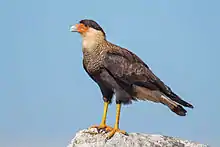 | |
| Serra da Canastra National Park | |
| Scientific classification | |
| Kingdom: | Animalia |
| Phylum: | Chordata |
| Class: | Aves |
| Order: | Falconiformes |
| Family: | Falconidae |
| Genus: | Caracara |
| Species: | C. plancus |
| Binomial name | |
| Caracara plancus (Miller, 1777) | |
| Synonyms | |
|
Polyborus plancus | |
Description
It has a total length of 50–65 cm (20–26 in) and a wingspan of 120–132 cm (47–52 in). Weight is 0.9-1.6 kg (2-3.5 lbs), averaging 1,348 g (2.972 lb) in 7 birds from Tierra del Fuego.[9][10] Individuals from the colder southern part of its range average larger than those from tropical regions (as predicted by Bergmann's rule) and are the largest type of caracara. In fact, they are the second largest species of falcon in the world by mean body mass, second only to the gyrfalcon.[10] The cap, belly, thighs, most of the wings and tail-tip are dark brownish, the auriculars, throat and nape are whitish-buff, and the chest, neck, mantle, back, uppertail-coverts, crissum (the undertail coverts surrounding the cloaca) and basal part of the tail are whitish-buff barred dark brownish. In flight, the outer primaries show a large conspicuous whitish-buff patch ('window'), as in several other species of caracaras. The legs are yellow and the bare facial skin and cere are deep yellow to reddish-orange. Juveniles resemble adults, but are paler, with streaking on the chest, neck and back, grey legs, and whitish, later pinkish-purple, facial skin and cere.
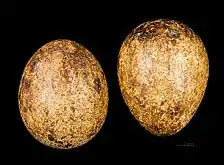 Eggs MHNT
Eggs MHNT_head_juvenile.JPG.webp) juvenile
juvenile_head_young_bird.JPG.webp) young adult
young adult_head_adult.JPG.webp) adult
adult.JPG.webp)
Behavior
A bold, opportunistic raptor, the crested caracara is often seen walking around on the ground looking for food. It mainly feeds on carcasses of dead animals, but will steal food from other raptors, raid bird nests, and take live prey if the possibility arises (mostly insects or other small prey, but at least up to the size of a snowy egret), it may also eat fruit. It is dominant over the black and turkey vulture at carcasses. It is typically solitary, but several individuals may gather at a large food source (e.g. dumps). Breeding takes place in the austral spring/summer in the southern part of its range, but timing is less strict in warmer regions. The nest is a large open structure, typically placed on the top of a tree or palm, but sometimes on the ground. Average clutch size is two eggs.
_2.jpg.webp) young adult, showing the distinctive light 'windows' in the wings
young adult, showing the distinctive light 'windows' in the wings_in_flight.JPG.webp) adult
adult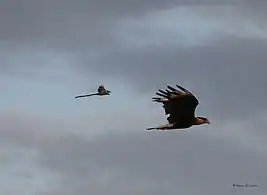 Being mobbed by a fork-tailed flycatcher
Being mobbed by a fork-tailed flycatcher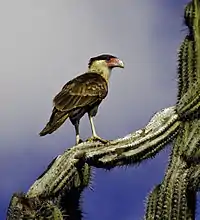 Young adult perched on a cactus, Bonaire, BES Islands
Young adult perched on a cactus, Bonaire, BES Islands%252C_Attwater_Prairie_Chicken_National_Wildlife_Refuge%252C_Colorado_County%252C_Texas%252C_USA_(24_May_2014).jpg.webp) Crested caracara (Caracara cheriway), Attwater Prairie Chicken National Wildlife Refuge, Colorado County, Texas, USA
Crested caracara (Caracara cheriway), Attwater Prairie Chicken National Wildlife Refuge, Colorado County, Texas, USA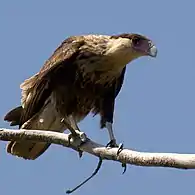 An immature bird surveying the surroundings in Texas, USA
An immature bird surveying the surroundings in Texas, USA
Distribution and habitat
The crested caracara occurs from Tierra del Fuego in southernmost South America north to southern United States, Mexico, and Central America. An isolated population occurs on the Falkland Islands. It avoids the Andean highlands and dense humid forest, such as the Amazon rainforest, where it is largely restricted to relatively open sections along major rivers. Otherwise, it occurs in virtually any open or semi-open habitat and is often found near humans.
Florida caracara
The state of Florida is home to a relict population of northern caracaras that dates to the last glacial period, which ended around 12,500 BP. At that point in time, Florida and the rest of the Gulf Coast was covered in an oak savanna. As temperatures increased, the savanna between Florida and Texas disappeared.[11] Caracaras were able to survive in the prairies of central Florida as well as in the marshes along the St. Johns River. Cabbage palmettos are a preferred nesting site, although they will also nest in southern live oaks.[12] Their historical range on the modern-day Florida peninsula included Okeechobee, Osceola, Highlands, Glades, Polk, Indian River, St. Lucie, Hardee, DeSoto, Brevard, Collier, and Martin counties.[13] They are currently most common in DeSoto, Glades, Hendry, Highlands, Okeechobee and Osceola counties.[14] Loss of adequate habitat caused the Florida caracara population to decline, and it was listed as threatened by the United States Fish and Wildlife Service in 1987.[13]
Crested caracara in Mexico
The Mexican ornithologist Rafael Martín del Campo proposed that the northern caracara was probably the sacred "eagle" depicted in several pre-Columbian Aztec codices as well as the Florentine Codex. This imagery was adopted as a national symbol of Mexico, and is seen on the flag among other places. Since the paintings were interpreted as showing the golden eagle, it became the national bird.[15]
Texan eagle
Balduin Möllhausen, the German artist accompanying the 1853 railroad survey, led by Lt. Amiel Weeks Whipple, from the Canadian River to California along the 35th parallel, recounted observing what he called the "Texan Eagle," which, in his account, he identified as Audubon's Polyborus vulgaris. This sighting occurred in the San Bois Mountains in southeastern Oklahoma.[16]
Status
Throughout most of its range, it is common to very common. It is likely to benefit from the widespread deforestation in tropical South America. It is therefore considered to be of Least Concern by BirdLife International.
References
- BirdLife International (2012). "Caracara plancus". IUCN Red List of Threatened Species. 2012. Retrieved 26 November 2013.CS1 maint: ref=harv (link)
- "Rare Raptors". Golden Gate Raptor Observatory. Archived from the original on 3 October 2009. Retrieved 22 August 2009.
- "caracara sighting record". Project Noah. 13 February 2012.
- "What's this crested caracara doing in Nova Scotia? | CBC News". CBC. Retrieved 2021-01-14.
- Scot, Stewart. "News". Nature Photography by Scot Stewart. Retrieved August 2, 2016.
- Bernard, Daryl. "Crested Caracara". iNaturalist.org. Retrieved August 2, 2016.
- "Pictured Rocks National Lakeshore Instagram". Retrieved August 2, 2016.
- Corbett, Tanya. "News". CBC News. Retrieved June 28, 2017.
- Info about the southern caracara at Zootierliste.de
- CRC Handbook of Avian Body Masses, 2nd Edition by John B. Dunning Jr. (Editor). CRC Press (2008), ISBN 978-1-4200-6444-5.
- "Chapter VIII. Florida Relict Species". Resource Guide. Indian River Lagoon Envirothon. Retrieved 23 January 2009.
- "Audubon's Crested Caracara" (PDF). South Florida Ecological Services Office. United States Fish and Wildlife Service. Retrieved 23 January 2009.
- Morrison, J.L. (October 2004). "The Crested Caracara in the changing grasslands of Florida" (PDF). In Noss, R. (ed.). Land of Fire and Water: The Florida Dry Prairie Ecosystem. Proceedings of the Florida Dry Prairie Conference, October 2004. Sebring, Florida. pp. 211–215.
- "Species Profile: Crested Caracara". Florida Fish and Wildlife Conservation Commission. Retrieved 10 August 2014.
- González Block, Miguel A. (2004). "El Iztaccuahtli y el Águila Mexicana: ¿Cuauhtli o Águila Real?". Arqueología Mexicana (in Spanish). XII (70): 60–65. Archived from the original on 2009-02-16.
- Möllhausen, Balduin (1858). Diary of a Journey from the Mississippi to Coasts of the Pacific With a United States Government Expedition. Longman, Brown, Green, Longmans, & Roberts. p. 45.
- Dove, C. & R. Banks. 1999. A Taxonomic study of Crested Caracaras (Falconidae). Wilson Bull. 111(3): 330–339. Available online (PDF)
- Ferguson-Lees, J., D. Christie, P. Burton, K. Franklin & D. Mead (2001). Raptors of the World. Christopher Helm. ISBN 0-7136-8026-1
- Restall, R., C. Rodner, & M. Lentino (2006). Birds of Northern South America. Vol. 1 & 2. Helm, London. ISBN 0-7136-7242-0 (vol. 1); ISBN 0-7136-7243-9 (vol. 2)
- Schulenberg, T., D. Stotz, D. Lane, J. O'Neill, & T. Parker III (2007). Birds of Peru. Helm, London. ISBN 978-0-7136-8673-9
External links
| Wikimedia Commons has media related to Caracara plancus. |
- Photos and text - arthurgrosset.com
- Photos and text - faunaparaguay.com
